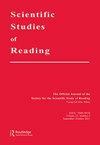The Effect of Syllable-level Hyphenation on Novel Word Reading in Early Finnish Readers: Evidence from Eye Movements
IF 2.4
2区 教育学
Q1 EDUCATION & EDUCATIONAL RESEARCH
引用次数: 2
Abstract
ABSTRACT In early Finnish reading instruction, hyphens are used to denote syllable boundaries. However, this practice slows down reading already during the 1st grade. It has been hypothesized that hyphenation forces readers to rely more on phonology than orthography. Since hyphenation highlights the phonology of the word, it may facilitate reading during the very first encounters of the word. To assess whether this is the case, Finnish 1st and 2nd graders read stories about fictional animals while their eye movements were registered. Each story included four occurrences of a novel target (pseudo)word, hyphenated at the syllable level in half of the stories. Target words were read faster with repeated exposure but there were no effects regarding grade or hyphenation. The use of hyphenation does not give rise to enhanced processing of phonology in novel words and is likely to hinder the processes connected to the use of orthography.音节水平的连字对早期芬兰语读者阅读新单词的影响:来自眼球运动的证据
在早期的芬兰语阅读教学中,连字符用来表示音节的边界。然而,这种做法在一年级时就已经减缓了阅读速度。据推测,连字符迫使读者更多地依赖音系而不是正字法。由于连字符突出了单词的音系,它可能有助于在第一次遇到单词时阅读。为了评估情况是否如此,芬兰一年级和二年级的学生在阅读虚构动物的故事时,记录了他们的眼球运动。每个故事都有四次出现一个新的目标(伪)词,其中一半的故事在音节级别上连字符。重复暴露后,目标单词的阅读速度更快,但对等级和连字符没有影响。使用连字符并不会增强对新单词的音系处理,而且可能会阻碍与正字法使用相关的处理。
本文章由计算机程序翻译,如有差异,请以英文原文为准。
求助全文
约1分钟内获得全文
求助全文
来源期刊

Scientific Studies of Reading
Multiple-
CiteScore
7.20
自引率
2.70%
发文量
26
期刊介绍:
This journal publishes original empirical investigations dealing with all aspects of reading and its related areas, and, occasionally, scholarly reviews of the literature, papers focused on theory development, and discussions of social policy issues. Papers range from very basic studies to those whose main thrust is toward educational practice. The journal also includes work on "all aspects of reading and its related areas," a phrase that is sufficiently general to encompass issues related to word recognition, comprehension, writing, intervention, and assessment involving very young children and/or adults.
 求助内容:
求助内容: 应助结果提醒方式:
应助结果提醒方式:


